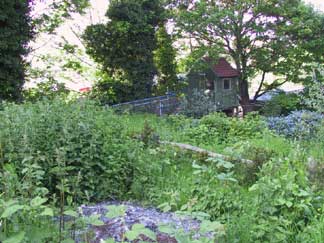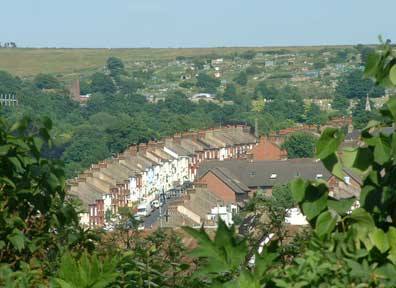A wild past - and future
by David Hodd Round Hill Reporter" October 2001 David Hodd muses on Round Hill's past as an area rich in widlife and fills us in on a survey carried out by some Round Hill kids in summer 2001 on land to the NE of Princes Rd.

So what do we know of the wildlife habitats at Round Hill over the years? Well in one small hill we had a microcosm of the whole South Downs landscape - sheep down and arable.
Chalk downland
Before the Round Hill Estate was constructed from the early 1860's, Round Hill was part of the Downs.

The steeper east side (Richmond Rd and Round Hill Crescent) was probably chalk downland like that at Whitehawk Hill, or Bevendean Down. As Brighton expanded, part of this slope was planted as an orchard. This still survives near the cat creep. The gentler west side (west of the windmill, down to Beaconsfield Villas) was in fact a "laine" - common arable ground not dissimilar to allotments - for a long time.
40 plants per square metre
In terms of wildlife, Chalk Downland is the richest habitat for plant life in Europe - as many as 40 plants in a square metre of turf. The messy organic laines would have had plenty of cornfield weeds, and rough patches in which small mammals could shelter. Bird life would have been very diverse too. Not only would we have seen Pipits and Skylarks, but there would have been Corncrakes, and perhaps the Stone Curlew and Great Bustard birds which today few of us have heard of .
Any survivors?
What we don't really know is if there is anything left of this wildlife rich past. In Bevendean, many people's gardens are still home to the chalk down land plants that the estate was built on in the 1950's. But for 140 years in Round Hill our gardens have been the only place for wildlife. Can there really be any survivors from 140 years of changing garden fashions? Nature is tenacious, and even if there is little which has survived there is every reason to believe that with the right care in our gardens, we can invite wildlife back in.
The hunt for critters
Although we haven't yet established what plant survivors (if any) there are from the past, some local children did get together during the summer holidays to see just how many living beasties they could find in one large garden in Princes Road. This survey was carried out in August by seven kids, who started by making a list of what had already been found in the garden recently. They then spent a long summer afternoon setting pit fall traps and running around with sweep nets and pooters. Two enthusiastic amateurs armed with wildlife guides were on hand to help identify the creatures found. Amazingly, they found 63 different creatures on that day, many of them mini beasts.
More surveys to come The Round Hill Society are planning to map these findings, conduct more such surveys next summer and gradually build a clear picture of just what is wild in Round Hill. For this we need more kids (with supervising parents) to join in during the 2002 Summer Holidays. We also want to know what wildlife you have seen in the area - birds, foxes, hedgehogs toads, whatever - drop me a letter (or e-mail david.hodd@bigwig.net ) with a list of the wildlife you have seen in your garden, when you last saw them and whether they are or were nesting in the area.
How to encourage wildlife in Round Hill?
Put a pond in your garden Have a wildflower meadow in part of your garden Never use chemicals to control pests Don't have a cat Put up nest boxes Feed birds through the winter Don't have a tidy garden Grow a variety of flowers, especially nectar rich ones.
Having read the list you might be sceptical about why you would even want to have wildlife in your garden.
The answer is simple - without it Round Hill would be sterile and boring. The only way to stop the area becoming lifeless is for some of us to spare some space in our gardens for wildlife.

Just one of the 63 different creatures - which included toads, Common Newts, Hawker Dragonflies, Hummingbird Hawkmoths, Frogs and Rufous Grasshoppers - that were found during the wildlife survey at 67 Princes Road.
Postscript to David Hodd's 2001 article
Diggers move in on wildlife habitat Before any planning permission was granted, the developer Carelet cleared the site using an eath-digger and chain-saws on 12th/13th June 2005.




Wild flower protection
[from "Sussex Wild Flowers" by Mary Briggs MBE published by Sussex Wildlife Trust 2004]
All wild plants are given protection under British law.
Under the Wildlife and Countryside Act 1981 and later the Countryside and Rights of Way Act 2000, it is illegal to uproot any wild plant without permission from the landowner. Plants on nature reserves and nationally designated sites, (including National Nature Reserves and Sites of Special Scientific Interest) also have strong protection. It is illegal to pick, uproot or remove plants for example on Wildlife Trust nature reserves or National Trust land.
Some plants are specifically protected under Schedule 8 of the Wildlife and Countryside Act 1981. This Act provides a list of endangered plants, that are protected against intentional picking, uprooting and destruction. Schedule 8 of the Wildlife and Countryside Act is revised every five years. Current lists of the species afforded special protection in Britain are listed at www.bsbi.org.uk , the website of the Botanical Society of the British Isles.
Other Useful Websites
Sussex Wildlife Trust
Sussex Biodiversity Records Centre
English Nature
This page was last updated by Ted on 30-Jun-2020

So what do we know of the wildlife habitats at Round Hill over the years? Well in one small hill we had a microcosm of the whole South Downs landscape - sheep down and arable.
Chalk downland
Before the Round Hill Estate was constructed from the early 1860's, Round Hill was part of the Downs.

The steeper east side (Richmond Rd and Round Hill Crescent) was probably chalk downland like that at Whitehawk Hill, or Bevendean Down. As Brighton expanded, part of this slope was planted as an orchard. This still survives near the cat creep. The gentler west side (west of the windmill, down to Beaconsfield Villas) was in fact a "laine" - common arable ground not dissimilar to allotments - for a long time.
40 plants per square metre
In terms of wildlife, Chalk Downland is the richest habitat for plant life in Europe - as many as 40 plants in a square metre of turf. The messy organic laines would have had plenty of cornfield weeds, and rough patches in which small mammals could shelter. Bird life would have been very diverse too. Not only would we have seen Pipits and Skylarks, but there would have been Corncrakes, and perhaps the Stone Curlew and Great Bustard birds which today few of us have heard of .
Any survivors?
What we don't really know is if there is anything left of this wildlife rich past. In Bevendean, many people's gardens are still home to the chalk down land plants that the estate was built on in the 1950's. But for 140 years in Round Hill our gardens have been the only place for wildlife. Can there really be any survivors from 140 years of changing garden fashions? Nature is tenacious, and even if there is little which has survived there is every reason to believe that with the right care in our gardens, we can invite wildlife back in.
The hunt for critters

Although we haven't yet established what plant survivors (if any) there are from the past, some local children did get together during the summer holidays to see just how many living beasties they could find in one large garden in Princes Road. This survey was carried out in August by seven kids, who started by making a list of what had already been found in the garden recently. They then spent a long summer afternoon setting pit fall traps and running around with sweep nets and pooters. Two enthusiastic amateurs armed with wildlife guides were on hand to help identify the creatures found. Amazingly, they found 63 different creatures on that day, many of them mini beasts.

More surveys to come The Round Hill Society are planning to map these findings, conduct more such surveys next summer and gradually build a clear picture of just what is wild in Round Hill. For this we need more kids (with supervising parents) to join in during the 2002 Summer Holidays. We also want to know what wildlife you have seen in the area - birds, foxes, hedgehogs toads, whatever - drop me a letter (or e-mail david.hodd@bigwig.net ) with a list of the wildlife you have seen in your garden, when you last saw them and whether they are or were nesting in the area.
How to encourage wildlife in Round Hill?
Put a pond in your garden Have a wildflower meadow in part of your garden Never use chemicals to control pests Don't have a cat Put up nest boxes Feed birds through the winter Don't have a tidy garden Grow a variety of flowers, especially nectar rich ones.
Having read the list you might be sceptical about why you would even want to have wildlife in your garden.
The answer is simple - without it Round Hill would be sterile and boring. The only way to stop the area becoming lifeless is for some of us to spare some space in our gardens for wildlife.

Just one of the 63 different creatures - which included toads, Common Newts, Hawker Dragonflies, Hummingbird Hawkmoths, Frogs and Rufous Grasshoppers - that were found during the wildlife survey at 67 Princes Road.
Postscript to David Hodd's 2001 article
Diggers move in on wildlife habitat Before any planning permission was granted, the developer Carelet cleared the site using an eath-digger and chain-saws on 12th/13th June 2005.




Wild flower protection
[from "Sussex Wild Flowers" by Mary Briggs MBE published by Sussex Wildlife Trust 2004]
All wild plants are given protection under British law.
Under the Wildlife and Countryside Act 1981 and later the Countryside and Rights of Way Act 2000, it is illegal to uproot any wild plant without permission from the landowner. Plants on nature reserves and nationally designated sites, (including National Nature Reserves and Sites of Special Scientific Interest) also have strong protection. It is illegal to pick, uproot or remove plants for example on Wildlife Trust nature reserves or National Trust land.
Some plants are specifically protected under Schedule 8 of the Wildlife and Countryside Act 1981. This Act provides a list of endangered plants, that are protected against intentional picking, uprooting and destruction. Schedule 8 of the Wildlife and Countryside Act is revised every five years. Current lists of the species afforded special protection in Britain are listed at www.bsbi.org.uk , the website of the Botanical Society of the British Isles.
Other Useful Websites
Sussex Wildlife Trust
Sussex Biodiversity Records Centre
English Nature